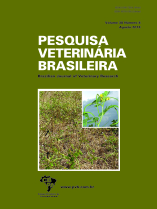 |
|
|
|
Year 2018 - Volume 38, Number 8
|

|
An outbreak of malignant catarrhal fever in Sambar deer (Rusa unicolor), 38(8):1675-1680
|
ABSTRACT.- Oliveira M.C., Pereira G.O., Daoualibi Y., Dutra V., Brito M.F., Caldas S.A., Balthazar D.A. & Ubiali D.G. 2018. An outbreak of malignant catarrhal fever in Sambar deer (Rusa unicolor). Surto de febre catarral maligna em cervos Sambar (Rusa Unicolor). [Surto de febre catarral maligna em cervos Sambar (Rusa Unicolor).] Pesquisa Veterinária Brasileira 38(8):1675-1680. Setor de Anatomia Patológica, Departamento de Epidemiologia e Saúde Pública, Anexo do Instituto de Veterinária, Universidade Federal Rural do Rio de Janeiro, BR‑465 Km 7, Seropédica, RJ 23890-001, Brazil. E-mail: danielubiali@hotmail.com
Malignant catarrhal fever (MCF) is an infectious, pansystemic and highly fatal disease with wide geographic distribution. The species that are clinically prone to it include cattle, deer and bison. In Brazil, the disease in ruminants and deer is associated with the contact with sheep, especially during labor, when the fetal remains that are eliminated contain the ovine herpesvirus 2 (OvHV-2). The outbreak took place in a conservationist property in the city of Casimiro de Abreu/RJ, which hosted 23 Sambar deer, and, of these, 19 died, showing neurological signs. The deer lived in a location together with 15 male and female meat sheep. A female specimen of the Sambar deer (Rusa unicolor), aged approximately three years, which had presented with neurological clinical signs was referred to necropsy in the Setor de Anatomia Patológica at Universidade Federal Rural do Rio de Janeiro (SAP/UFRRJ). During necropsy, cerebrospinal fluid was sampled for analysis; fragments of several organs were fixated in 10% buffered formalin and processed for histopathological analysis. Fragments of occipital lobe, cerebellum and bulb were collected to perform the polymerase chain reaction (PCR). The diagnosis of this outbreak was based on epidemiological, clinical and pathological findings, and on the amplification of the OvHV-2 DNA through PCR. The histological changes were the base to confirm the MCF case and were characterized by degeneration of vascular endothelial cells, fibrinoid vasculitis, hyperplasia and necrosis of lymphoid organs. However, PCR was an important tool to confirm the diagnosis. MCF as an important disease with nervous symptomatology in deer. |
| |
|
|
| |
|
 |